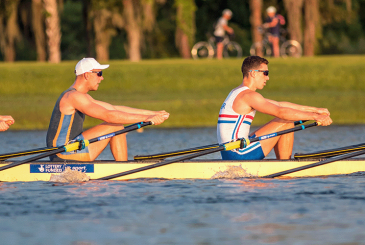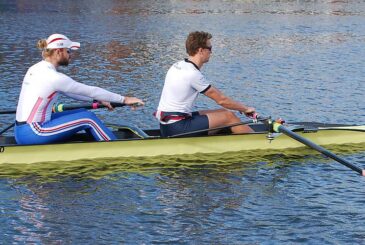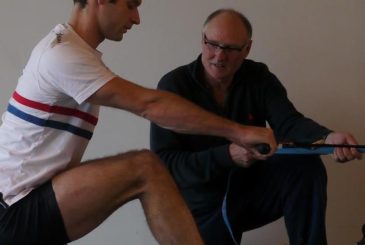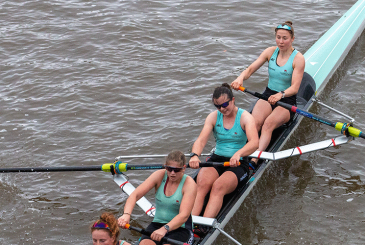How should you divide your training sessions? Coach Consultant Robin Williams shares some ideas for how you can optimise your time
In a typical rowing week, it is always a challenge to decide how to divide your training time between physical training, technique, strength and flexibility.
Although there are some who see training and technique as separate activities, I am convinced you can – and need – to combine them and be time-efficient too. After all, there is little value in just having a powerful engine if a poor gearbox wastes the energy and prevents efficient use of your power, and conversely rowing is not a dressage sport either – we all know how hard rowers train in order to move a boat well.
Much depends on how many hours or sessions per week you can fit in.
The more sessions you can do, the more balanced you have to be with your training mix to avoid overload.
National team full-time athletes might do 16 sessions or more per week and therefore allocate one or two specifically for technique work; those training for half of that number may not have the luxury of ‘giving away’ a whole session for it. So, here are some ideas for how you can optimise your time.
In my coaching days at Cambridge we used to set up racing videos on screens and run through race starts and simulations for Boat Race day
Five good habits
1 – Use the rowing machine well
It is likely you will do around 15-20% of your annual training volume on the rowing machine. Think about the winter time when it is dark and conditions do not permit water training, but even in the summer the rowing machine is used just because it is so time-efficient, especially if you have one at home or at work. Certainly, in 2020, the ergo has been a mainstay of training during lockdown.
Yet we often see some pretty poor ergo technique which does little to advance our boat-moving ability and it is a shame to miss the opportunity to reinforce good technique. True, a static rowing machine mostly rewards the drive phase rather than recovery, whereas in the boat the recovery movements are very key to maintaining boat speed and setting up the next stroke.
Also true is that people tend to ‘switch off’ on the rowing machine and just get the work done, but it doesn’t have to be like that.
As you fatigue, technique sometimes deteriorates, but there are drills you can do without stopping
The first step is to have the right culture in the ergo room, so that everyone has some pride in there and, ideally, gives each other feedback and encouragement. Many clubs have wall mirrors or moveable ones, and even fixed CCTV-style cameras feeding to screens in the room to give people training feedback.
In my coaching days at Cambridge we used to set up racing videos on screens and, with a low damper setting, run through race starts and simulations together to get ready for Boat Race day – a version of visualisation training. The mood in the room was purposeful, fun, and it definitely combined the training/technique objectives. For coxes, this is a great way to run through your calls in a live, but privately controlled situation.
You can also get inventive with basic sessions: the power delivery in rowing is important, so using the watts setting rather than a 500m split gives a more sensitive feedback.
Warm-up drills might include some legs only, trunk only, arms only to see how many watts you produce with each of the three separate body segments; then try combining legs and trunk, or trunk and arms – it is surprising how much stronger combination movements are than isolated ones. Your trunk, for instance, feels twice as strong with even a tiny bit of slide, compared to a fixed seat.
The power curves are helpful here too and, as you add each segment, you can learn how to build a strong, combined curve without bumps and dips. After the warm-up, you could try a training pyramid which is good for developing control of your power and rate. See if you can maintain output to +/- 1 watt at each level, or if that’s too hard try +/- 5 watts. This is good for feel.
Incidentally, dividing the watts by your body weight will give a watts per kg value and this is very motivational as you get fitter and leaner. It also allows smaller people to be ranked against larger ones. Absolute power is important but so is power to weight ratio.
Dynamic rowing machines offer some other training/technique benefits because there is more skill involved with the recovery. Get it wrong and the sliding ergo head, or seat, will crash the end stop.
Thinking is the main driver for good technique
These rowing machines encourage good sequencing and seamless hands/body/slide. They also reinforce a key concept for the boat which is that ‘the boat comes to you’. That just means that the rower needs to recover in the first part of the recovery (to a quarter slide position), but after that you will need to sit still and allow the hull to bring the legs to you. Better to have the 14kg of a single slide to you than, say, 80kg of you arrive heavily on the stern!
If you want to find out more about rowing machine technique there are several online videos, including a series of eight that I produced during lockdown.
2. On the water: have a decent outing plan
Some rowers seem to hare around at a 100 miles per hour, hurry to get afloat and get the distance done, shower and get home. They do the programme, but maybe without enough forethought and possibly without really engaging with each other.
No one wants time-wasting either, but a couple of minutes by the boat rack, as a crew, to collect heads and outline the session is worth doing. Details need to include total kms/time, any work pieces and what the aims are, general water conditions or other relevant factors (e.g. the river is really quiet/busy). This just gets brains engaged and sets the tone for the session. Thinking is the main driver for good technique.
3. On the water: use the warm-up
Crews usually run through some warm-up drills in the first 10 minutes of a session, building up from back stops, or in pairs etc, but not always with enough thought. Often, they repeat the same routine day in, day out.
Let’s imagine a 16km session: the warm-up phase might last 2-3km, beginning with mobilisation and sequencing work like a back-end build-up. This creates technical references for the crew, so there is balance and a sense of moving together. It is also a form of in-boat stretching and mobilisation, so you can achieve the positions comfortably when you introduce full length. The warm-up can end with some pressure work before starting the main training block.
Whatever you do it pays to vary the routine, so it doesn’t become just a pointless habit.
A useful online video is Golden Glory featuring 2008 Olympic champions Mark Hunter and Zac Purchase going through a typical warm-up routine, with commentary.
Crews training on shorter stretches of water often lose 15-20% of training time just turning the boat, so you can make this a technique challenge too
4. On the water: technique on the move
Having set the technical template in the warm-up, the session now needs to be continuous, assuming it is a UT aerobic one and the rule is ‘keep the hull moving’.
Consistent boat speed, length, distance per stroke (DPS is obviously the combination of power phase and recovery) are the aims.
As you fatigue, technique sometimes deteriorates, but there are drills you can do without stopping.
If balance is not great, try putting in one pause stroke in every 15 normal ones. Pausing at the finish, hands away or wherever you feel control is needed. In a pure technique session, you might do the pause every stroke, but then heart rates will drop, as will boat speed, and rate.
Doing just occasional drill strokes means they work more as reminders and just give rowers the chance to check reference positions and timing points whilst still maintaining the physical objectives.
Perhaps the boat has gone a little heavy, so a drill could be as simple as putting in rate changes every minute (up two, down two), and if concentration is the reason then this might just wake things up enough.
Stretching and mobility will contribute to your in-boat technique
Alternatively, if the power feed is not right then dropping to three-quarters slide, but maintaining hull speed for 10 strokes, can be useful. It is shorter, for sure, but with slightly stronger positions and less arc it is possible to produce the dynamic stroke you want, improve hull speed, and then go out to full length again.
Crews training on shorter stretches of water often lose 15-20% of training time just turning the boat, so you can make this a technique challenge too – turn it in under 30” and do a sub-max 10 stroke start after the turn to get the hull speed back and maintain heart rates. This can be effective at refreshing the rhythm.
There are countless things you can do on the move, as long as the crew understands what is missing, and what you are going to do to improve it. Acceleration, glide, movement sequencing, positions, rhythm, balance – these things can all be addressed while still training.
5. Off the water
Finally, there is much you can do to help technique off the water.
In the weights room, like on the ergo, the point is to ‘train the chain’ for rowing and see the rowing value in a power clean movement, squat or bench pull, rather than regarding them as a separate sport.
Stretching and mobility will contribute to your in-boat technique, and any skill-activity such as ball games which build hand/eye coordination, body awareness, balance, and dynamic movement can add to your weekly total of technique minutes.
Photo: John Anderson










